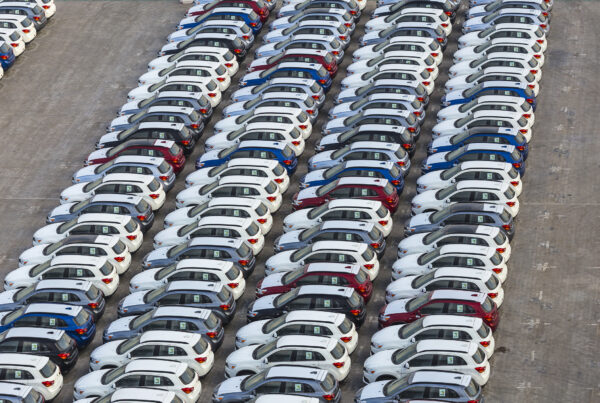The Australian used car market continues to change, influenced by shifting economic factors, global trends, and the growing popularity of electric vehicles (EVs). Andrew Tyson, National Sales Manager for Motor Vehicles at Pickles, shared an update on the used car market, focusing on vehicles across Australia and Queensland, including trends in EVs.
Used Car Price Trends: A National and State-Level View
The Used Car Index shows how vehicle prices have changed since January 2020. Australia saw a peak in March 2022 at 154 per cent compared to pre-pandemic levels. By September 2024, the index had dropped to 121 per cent.
Queensland followed a similar trend to the national market, with a slightly lower peak in March 2022. The most recent quarter shows a slight flattening of prices in Queensland.
“At the moment, we’re actually seeing a bit of a buck of that trend, certainly in the last six or seven months where it’s tending to flatten a little bit and it’s performing depending on segment and different types,” explained Andrew.
Trends Per Vehicle Category
When broken down by vehicle category (passenger, SUV, and light commercial vehicles), price trends in Queensland closely match national averages:
- Passenger Vehicles increased 133 per cent from January 2020 levels
- SUVs, 118 per cent
- Light Commercials, 104 per cent
Light commercial vehicles have seen the sharpest decline in values since their peak.
“The significant take-out here is that commercials have trended absolutely on a faster decline since the peak over the last two years,” said Andrew.
“So anywhere where you have a significantly large portion of commercials on your fleet, you’ve probably seen a bit of a decline in terms of your returns against residuals,” he added.
Andrew also explained that the availability of new vehicles directly influences the pricing of used cars.
“So passenger vehicles versus commercials versus SUVs, often what’s available new and what’s not available new will tend to inform the used car market at the same time in terms of how the price performs as well as that’s driven predominantly by the people buying them who are retailing them at the same time,” Andrew said.
Comparing Popular Utes
The two most popular utility vehicles, the Toyota Hilux and Ford Ranger, have shown different price trends in the used market. The Hilux is currently at 108 per cent of its January 2020 index, performing better than the Ranger at 98 per cent, even though both vehicles had similar new car sales volumes. The Hilux outsold the Ranger by up to 70 per cent during October 2021–October 2022.
The larger number of Rangers in the market contributes to greater price sensitivity compared to the Hilux, which traditionally holds stronger residual values.
“The very simple insight, if you ask me, is there are that many more Rangers in the marketplace at the moment. It’s informing the price sensitivity more so than Hilux, which traditionally is a strong performer around a residual value model, is maintaining a little bit stronger price across that period,” Andrew said.
Andrew noted that looking at new sales data alongside price trends for these vehicles can offer valuable insights into the used car market, helping predict price changes.
“When you look at the two periods, one was selling significantly more than the other when one was performing better at a used car level. But again, the underlying volume-to-demand supply element informs the used vehicle part at the back end at the same time,” he explained.
Vendor Types on the Used Car Market
In September 2024, used car prices in Australia by vendor type revealed some interesting trends. Lease companies led the way, with prices at 120.8 per cent of January 2020 levels. General government and council vehicles followed at 119.5 per cent and 112.8 per cent, respectively.
“Vendor types, again, we’re lucky to deal across lots of different customers… Currently, the best-performing segment on the index is a leasing company,” Andrew said.
Notably, councils were historically strong performers in the used car market but have recently lagged behind other vendor types. However, the market for council vehicles is improving, with increased demand pushing prices up.
“We’re now seeing a larger portion of council vehicles coming to market which are well sought after, which people want, which is driving demand, which is driving price,” he explained.
Differences in Fuel Type
As of September 2024, hybrid vehicles lead the way with a price index of 128 per cent—showing the least decline since their peak. This is linked to the growing shift toward more fuel-efficient vehicles. Hybrids are becoming a popular choice for fleets and consumers seeking a balance of eco-friendliness and practicality.
“Hybrids being really strong and have been consistently the best out of the petrol types in the last year and a half.”
While petrol vehicles still dominate the market (38 per cent of total sales), their price index stands at 122 per cent. Petrol cars remain a stable option for most buyers, but hybrids are gaining popularity due to stricter emissions regulations and rising fuel costs.
Diesel vehicles make up nearly half of the used car market (49 per cent of total sales), with a price index of 110 per cent. Though diesel prices have shown a slight decline, they remain a significant player in the market.
“I was surprised to see how many diesels were a percentage of our total sales, nearly 50%, but again, the trend’s not significantly different,” said Andrew.
Electric vehicles (EVs) have seen the sharpest decline, sitting at 109 per cent, despite representing less than 1 per cent of total vehicle sales.
“The key takeaways here are the volatility of electric vehicles over the period, like it’s a dartboard effect. No one knows what any EV’s worth at any given point, any given week.”
This makes pricing used EVs difficult. “It’s very hard to be experts on that at the minute… really hard to predict the price at the moment.”
Volatility of the Used EV Market
Used EV prices have fluctuated significantly over the past three years due to limited supply, rapidly changing models, and pandemic-driven demand. The price index for used EVs reached a 70 per cent increase, compared to 50 per cent for internal combustion engine (ICE) vehicles.
“We literally saw periods where you could order a brand new Model 3 for 58 grand, but we were auctioning them for 62,000 that same week,” Andrew recalled.
The main reason for this volatility is the lack of supply, and prices can spike when specific models become scarce. “There’s not a lot of them. It’s driving most of the volatility,” said Andrew.
The used EV market is stabilising as supply increases. However, with more models entering the market, prices are becoming less erratic, though still subject to fluctuations. As new brands, particularly from China, enter the market, pricing is expected to fall.
“An enormous amount of new brands are coming into the market in the next three or four years,” Andrew points out.
Furthermore, used EV volumes are growing, and forecasts suggest the market could triple annually. The mix of EV models is changing, with Hyundai’s Ioniq and Kona competing with Tesla Model 3.
“Tesla was predominantly what we were seeing. We’re seeing a lot more Hyundai product come into the market,” says Andrew. This shift is pushing average sale prices down.
Andrew also notes that “58 per cent of Pickles EV buyers are end users, compared to just 25 per cent for ICE vehicles,” showing that more private individuals and businesses are buying used EVs.
Trends in the EV Market
Several trends will shape the future of the EV market in Australia. The global push to produce more EVs will affect Australia, even though the country is adopting EVs more slowly than other places.
More brands, especially from China, will enter the market, which will help lower prices. “31 different makes are coming to the market in the next five years,” Andrew said.
There is also a growing demand for hybrid vehicles, which may become more popular than pure EVs in the used market. Andrew explains, “Most brands transitioning to hybrid PHEV, including BYD, are an example of how the market is evolving.”
However, Australia’s infrastructure isn’t ready for large-scale EV adoption. “We’re nowhere near where we need to be for mass adoption of EVs,” Andrew warns.
While more EVs on the market will lower prices, the market will still be unpredictable due to changes in consumer preferences and ongoing infrastructure issues.
AfMA would like to extend a heartfelt thank you to Andrew Tyson for sharing his expertise to our audience.
Did you find this article interesting? Click the ‘heart’ button above to give it a ‘like’!













